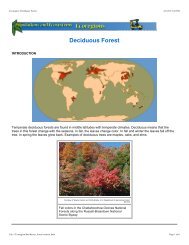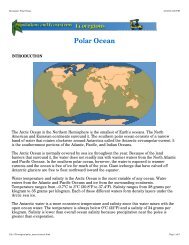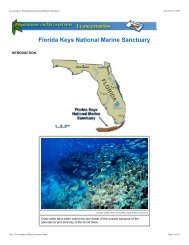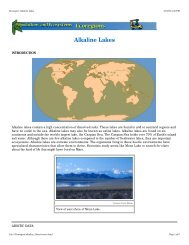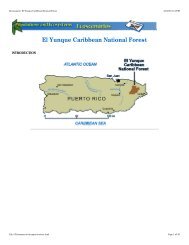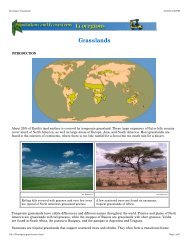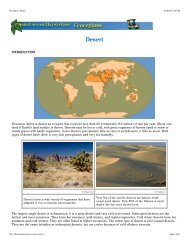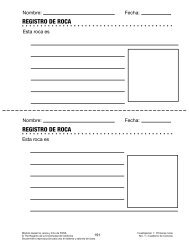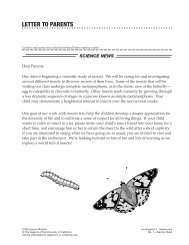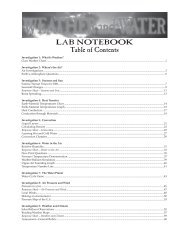Ecoscenarios Combined - FOSSweb
Ecoscenarios Combined - FOSSweb
Ecoscenarios Combined - FOSSweb
Create successful ePaper yourself
Turn your PDF publications into a flip-book with our unique Google optimized e-Paper software.
Ecoscenario: Mono Lake<br />
4/16/03 3:18 PM<br />
The lake was now maintaining, but not regaining its level. (Note: 1 cubic foot per second is about 450 gallons of water per minute!)<br />
David Gaines was killed in an automobile accident in 1988, but the work that he started continued. The California Supreme Court issued<br />
a landmark decision on September 28, 1994. It ruled that the LADWP had to renegotiate its license. It was required to release enough<br />
water to restore the lake to a level of 1948 meters (6391 feet), and enough water after that to stabilize Mono Lake at that level. This is<br />
expected to take 10–20 years. By October 1998, the water elevation was 1946 meters (6384 feet) and still rising. While 1948 meters<br />
(6391 feet) is below the pre-diversion level, it represents a compromise between the needs of natural systems and the needs of people.<br />
Courtesy of Teri Dannenberg<br />
Brush and shrubs that grew around exposed tufa towers die as the alkaline water inches<br />
back.<br />
This water level should guarantee the vitality of the ecosystem, prevent a land bridge from reaching Negit Island, allow trout to spawn in<br />
the freshwater creeks feeding Mono Lake, and ensure excellent scenic views for Mono Lake visitors. On September 28, 1994, the day of<br />
the decision, Marc Del Piero of the State Water Resources Control Board proclaimed, "Let this be known as the day we saved Mono<br />
Lake."<br />
Is Mono Lake saved? What demand will be placed on the precious fresh water flowing into the briny lake when California's human<br />
population, which is 35 million, reaches 50 million or more in a generation or two? Will we still have the will to protect the lake for the<br />
benefit of the shrimp, flies, and migratory birds? They do have a valid claim...they were here 760,000 years before us.<br />
THE DEBATE<br />
Before making decisions that affect an ecosystem, it is important to gather information from a variety of sources. Below are the views of<br />
several individuals or groups that have an interest in the future of Mono Lake. After each quote the hyperlink goes to the original source of<br />
the quote. Refer to these sites for more information.<br />
Use the information provided to decide where you stand on this debate.<br />
DEBATE: Should water be diverted from Mono Lake to southern California?<br />
People who support water-diversion level outlined by the 1998 court decision<br />
Los Angeles Department of Water and Power official<br />
"Our conservation efforts and contol of the lands in the Mono Lake basin has made the area a desirable vacation spot."<br />
Los Angeles Department of Water and Power, Recreational Uses of City of Los Angeles, Eastern Sierra Land<br />
"The Eastern Sierra is truly a recreation paradise, from the tall mountain peaks laced with lakes and streams to the valley floors. Visitors<br />
to, and residents of, this beautiful area will find much to enjoy. Most of the land is owned and administered by the United States Forest<br />
Service and the Bureau of Land Management."<br />
http://web.ladwp.com/~wsoweb/Aqueduct/recuses/recreationindex.htm<br />
Birdwatcher<br />
"In 1987 only 10,594 birds were counted in our annual fall shorebird count. In 2001 there were 40,606 and that doesn't even include the<br />
California gulls or eared grebes. There were over 28,000 red-necked phalaropes. Mono Lake is returning to its pre-diversion numbers of<br />
birds."<br />
Mono Basin Clearinghouse, Raw Data and Field Notes from Mono Lake - http://www.monobasinresearch.org/data/index.html<br />
People who support returning Mono Lake to its prediversion level<br />
file:///Ecoscenario/mono/content.html<br />
Page 9 of 11



